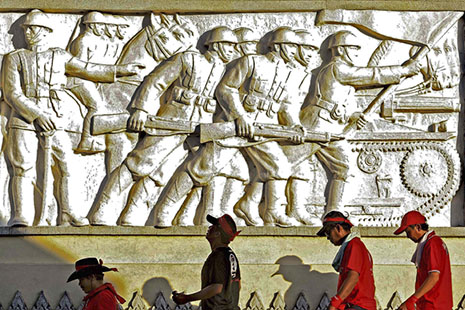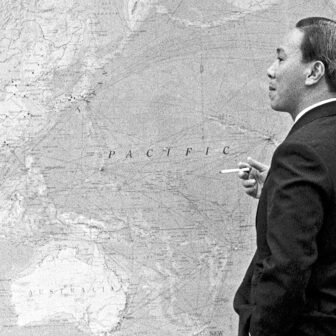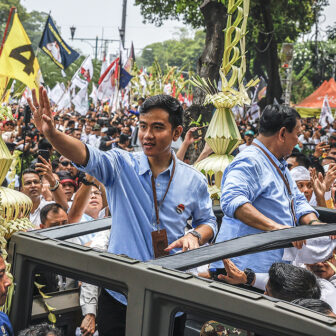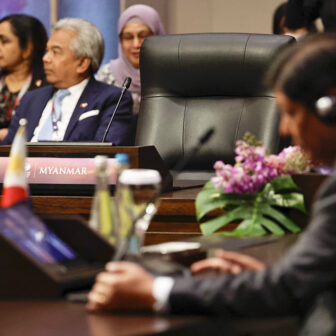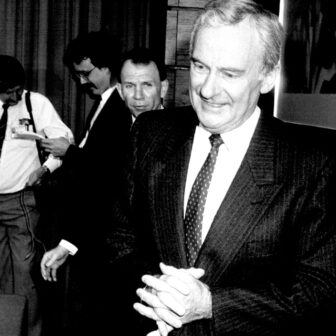THAILAND has been in political crisis for more than four years now, a seemingly endless cycle of constitutions, coalition governments, elections, coups, and demonstrations protesting the results of all of these events. Nowadays we have not just military coups, but also judicial coups that bring governments to power after the courts have banned political parties. The other day the possibility of a “pro-democracy coup” was mentioned – presumably this is a good coup.
The roots of the current conflict can be traced to a new constitution that came into force in 1997 and created a strong, elected executive. Thaksin Shinawatra, a wealthy and savvy telecommunications tycoon, led his Thai Rak Thai party to two successful national elections and was prime minister from 2001 to 2006. He was the first prime minister since the 1930s to challenge the monarchy openly, which he did by verbal and symbolic means that smacked of republicanism in the eyes of many Thai people. In early 2006 his government became seriously destabilised by street protests instigated by the People’s Alliance for Democracy, or PAD, whose supporters wear yellow, the colour for Monday, the day on which the present king was born. In a move that took the country by surprise, the army launched a coup in September 2006, dissolved the parliament and commenced writing yet another constitution, which came into force in 2007.
The new constitution allowed the courts to ban Thaksin’s party. Proxy parties won elections and formed a series of governments, provoking the PAD to recommence its fiery populist politics. With impunity, the PAD occupied Government House in late 2008 and forced the closure of Bangkok’s two airports in December of that year, shutting down the main artery of Thai commerce. In the same month a coalition, led by the Democrat Party, formed a government with the help of the army, business networks and powerful patrons. The United Front for Democracy against Dictatorship, a political and social movement that continues the legacy of Thaksin’s original party and its descendents, is now calling for the dissolution of parliament and fresh elections, which it feels confident of winning.
Although many of the causes of this conflict are manifestations of the social and economic changes of the past twenty years, the dynamics of the current struggles have been in place for many decades. Demands for a popular share in political power date back nearly eighty years to 1932, when a coalition of civilians and military officers brought Thailand’s absolute monarchy to an end. The seventh Bangkok king abdicated in 1935, leaving the monarchy at the nadir of its prestige and influence. But there had been signs of unrest in the army as far back as 1912, soon after the accession of King Vajiravudh, when a coup plot was uncovered; the leaders of the plot included a constitution in their program. In the late 1930s the army was ascendant again, and it seized power at the end of that decade. Field Marshal Plaek Phibunsongkhram, the prime minister from 1939 to 1944, was anti-royalist and populist but hardly a card-carrying democrat. With Thailand’s borders guaranteed by the western colonial powers from the middle of the nineteenth century, the army had become accustomed to governing and maintaining domestic order, its forces dispatched to round up bandits or quell disturbances.
To understand the present struggles in Thailand it is helpful to picture the broad avenue in the capital where many of the demonstrations for constitutions, elections and participatory politics have taken place. At the main intersection is Democracy Monument, built by the government of Field Marshal Phibun, which was world-famous for its striking design when it was finished in 1940, eight years after the 1932 coup. At the centre of the structure, overlooked by the soaring wings, is a pedestal holding a facsimile of the Thai constitution. There have been many constitutions since then, as governments coming to power see fit to rearrange the statutes to suit the power blocs that put them in office. The panels with sculpted figures decorating the base of the wings were designed by an Italian, Corrado Feroci, who drew inspiration from the politicised sculptures of fascist Italy and was forced to complete the relief sculptures in less than a year. The monument is unfinished, and in an unintended consequence of urban design, it is inconveniently located on a traffic island in the middle of a busy thoroughfare, Royal Progress Boulevard. Citizens and visitors must cross many lanes of fast-moving traffic and risk their lives if they wish to pay homage to Thai democracy.
So there you have it: an unfinished monument built by a military government commemorating a constitution that has been written too often to remember in celebration of a democracy that was not yet in existence, let alone secure. For most of its life, Democracy Monument has not performed very well as a symbol of Thai democracy. Little wonder that it is often defaced in the confrontations that take place around it, as it was when the Red Shirts left the area earlier this month. Those who mock Thai democracy may find themselves the object of curses conjured up on the steps of the monument in the heat of political protest.
But more than thirty-six years ago, on 14 October 1973, Democracy Monument did perform very well. That date saw the culmination of massive public protests that called for a new constitution and brought down a military government. Around 200,000 people filled the broad spaces along Royal Progress Boulevard, with tens of thousands more in the surrounding streets. It was a unique moment that touched almost everyone in the country. Never before in Thai history had public protest brought about a change of government. King Bhumibol received the demonstrators, and three military leaders beat a hasty retreat and left the country. Even with the violence and fatalities – seventy-seven people were killed and 857 wounded – the change of government was unambiguously righteous and promised the beginning of a new politics.
Although it still is the benchmark protest against which all other political demonstrations in Thailand are measured, the change of government it initiated didn’t take place through a legal, electoral process but by force of popular will. Mr Thaksin, who was twenty-four years old, had just finished his training at the police academy and was on his way to study policing in America. He too would have been touched by this event, and one wonders what lessons about popular protest he took away with him.
If 14 October 1973 is the benchmark event of political change that is unambiguously righteous, 6 October 1976 has become the benchmark event of violent suppression. On the morning of that day police and military units using high-powered weapons opened fire on a university campus near Democracy Monument. A small number of students who tried to escape were brutally lynched, raped or burnt alive outside the university. Officially, forty-three students and two policemen were killed, and over the next weeks 8000 people were arrested. More than 3000 young people, students, academics and intellectuals left the city and went into the jungle in different parts of the country. Some fled abroad.
The brutality of the coup disgusted the Thai public and the wider world and so tarnished the institutions of state that they took many years to recover. Just as the monarchy had a prominent role in October 1973, it was also associated with the lead-up to the crackdown, yet its involvement has rarely been mentioned, and then only in a few publications in English. In an effort to repair the damage and in a marked departure from his reluctance to speak to foreign media, in 1980 King Bhumibol allowed the BBC to make a documentary on the monarchy and the royal family, called The Soul of a Nation. In this television program we catch a glimpse of the pressures the monarchy felt then, and appears to feel now.
“We are in the middle,” King Bhumibol told the BBC. “We could be crushed by both sides….” The middle can be a position of strength, of course, but the king knew that it was a vulnerable position to be in if he was not careful. He could be crushed, so he needed protection. He had made an accommodation with the army when Field Marshal Sarit Thanarat came to power as prime minister in 1957, reversing in a stroke the poor relations between the two institutions in the decade after 1932.
A photograph from the time shows King Bhumibol and Sarit, who died in December 1963, apparently very relaxed in each other’s company. There are no illustrations in Paul Handley’s famous biography of the monarch, The King Never Smiles (2006), but this photograph could not fit the title of the book, because the king is smiling, as is Sarit. Two important institutions in Thai society needed each other at that time: Sarit needed respectability and prestige because of the way he had come to power; and the monarch needed protection.
From that time on, the army and the monarchy came to depend more and more on one another, and the symbiotic relationship between the two deepened. A Thai saying, “the boat needs water, the tiger needs jungle” (nam phoeng rua sua phoeng pa), puts it perfectly. The king needs the army, the army needs the king, although the dynamics of this mutual dependence have changed as historical circumstances have changed over the years. Presently the Privy Council, which advises the king, is headed by a general who was prime minister from 1980 to 1988. The prime minister appointed after the September 2006 coup was a general, and also from the Privy Council.
The army knows Democracy Monument and the narrow streets around it very well. As much as an image of democracy, the monument has become an image of soldiers with weapons trying to restore order. Recently, when General Anupong Paochinda was put in charge of such an operation, he said, “We don’t want any more deaths.” He is mindful not only of what happened on 10 April 2010, when the army’s first attempt to clear the streets led to twenty-two fatalities and over 800 wounded, but also of May 1992 – “Black May,” which had seen another violent confrontation between the army and tens of thousands of demonstrators on Royal Progress Boulevard – and October 1976.
Comparing the 1973 uprising with the demonstrations in Thailand in recent weeks, we can see many differences, especially the class and regional profiles of the demonstrators and the make-up of the respective Thai governments. At present we have a Thai government whose legitimacy is mortgaged in the sense that it owes its legitimacy to others – to the army, the courts, business interests and the Privy Council. It is in power not because it was voted into power but because it has been loaned its legitimacy by institutions and power blocs. And always in the background is the close relationship between army and monarchy.
The conclusion seems inescapable that the Thai political system cannot be seriously reformed until the knot tying the army and the monarchy together is cut. That is unlikely to happen in the near future, because the two institutions have something in common: they cannot tolerate a loyal opposition. Both institutions command loyalty by means of oaths and rituals of allegiance. Opposition is mutiny, or rebellion.
The Thai word for crisis is wikritthakan, one of those difficult Thai words to pronounce and spell. Like the Thai word, the present conflict seems intractable. Absolutism and despotism have always weighed heavily in the country’s history. Just beyond the street protests, the claims, and the counter-claims is the knot binding the monarchy to the army. •
